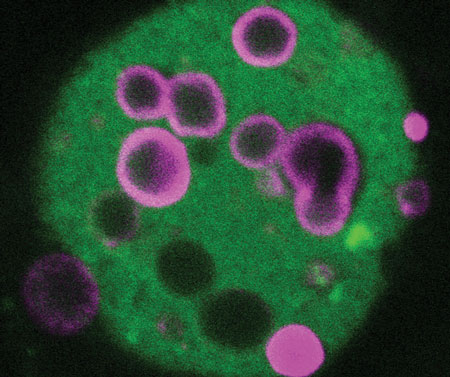Tiny calcium-based hydroxyapatite, commonly found in bones and teeth, could explain the origin of drusen, according to a new study published in Proceedings of the National Academy of Sciences . This not only offers a possible explanation for how age-related macular degeneration develops, but also opens up new ways to diagnose and treat the disease, the researchers say.

|
|
| Thousands of hydroxyapatite spheres (in magenta), each just a few microns across, are found in large drusen deposits within the eye. Photo: Imre Lengyel, PhD |
|
Through postmortem examination of 30 eyes from donors between 43 and 96 years old, the researchers used fluorescent dyes to identify the tiny spheres, each just a few microns across. The researchers believe that these calcium-based spheres attract proteins and fats to their surface, which build up over years to form drusen.
“We found these miniscule hollow spheres inside all of the eyes and all the deposits that we examined, from donors with and without AMD,” explains study leader Imre Lengyel, PhD, senior research fellow at University College of London’s Institute of Ophthalmology. “Eyes with more of these spheres contained more drusen. The spheres appear long before drusen become visible on clinical examination.”
Whether these spheres are a cause or a symptom of AMD is still unclear, but their diagnostic value is significant, the researchers say. As drusen are hallmarks of AMD, strategies to prevent buildup could potentially stop AMD from developing altogether.
“The dyes that we used should be compatible with existing diagnostic machines,” Dr. Lengyel says. “If we could develop a safe way of getting these dyes into the eye, we could advance AMD diagnoses by a decade or more and could follow early progression more precisely.”
The researchers also found that some of the spheres were coated with amyloid beta, which is linked to Alzheimer’s disease. If a technique were developed to identify these spheres for AMD diagnosis, they predict it could also aid early diagnosis of Alzheimer’s.
Thompson RB, Reffatto V, Bundy JG, et al. Identification of hydroxyapatite spherules provides new insight into subretinal pigment epithelial deposit formation in the aging eye. Proc Natl Acad Sci USA. 2015 Jan 20. [Epub ahead of print.]
